Taken in Paris, the first-prize photograph features the sitter Diena, in her first professionally posed photograph. The inaugural Taylor Wessing Photographic Commission is won by Serena Brown for her portrait me nana fie, which depicts the photographer’s younger sister visiting her family home in Accra, Ghana.
The exhibition is open to visitors from 9 November 2023 to 25 February 2024.
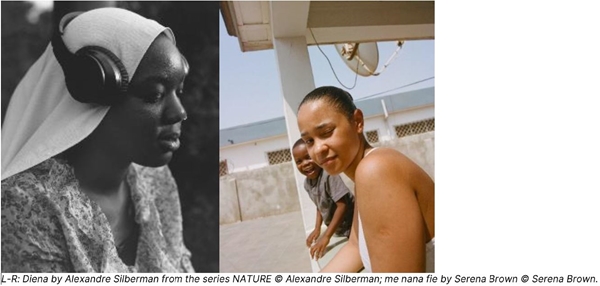
Alexandre Silberman has won first prize in the prestigious Taylor Wessing Photo Portrait Prize 2023 for his portrait, Diena.
Second prize was awarded to Gilleam Trapenberg for Kisha and LaDarayon, portraying a mother and son on the Caribbean Island of Saint Martin. A joint third prize was awarded to Jake Green for Shaun Ryder, an intriguing portrait of the Happy Monday's lead singer, and Carl Francois van der Linde for Chotu Lal Upside Down, depicting professional wrestlers from Punjab. The new Taylor Wessing Photographic Commission was awarded to Serena Brown for me nana fie, featuring the photographer's younger sister visiting her family home in Accra, Ghana, for the first time.
The winning portraits are now on display as part of the Taylor Wessing Photo Portrait Prize 2023 exhibition, which returns to the National Portrait Gallery for the first time in three years. The exhibition features 58 portraits from 51 photographers, selected for display by a panel of judges, including National Portrait Gallery's Director, Dr Nicholas Cullinan; Senior Curator at The Photographer's Gallery, Karen McQuaid; writer and photographer, Caleb Azumah Nelson; artist, Campbell Addy; and the National Portrait Gallery's Senior Curator of Photography, Sabina Jaskot-Gill.
First Prize £15,000: Alexandre Silberman for Diena
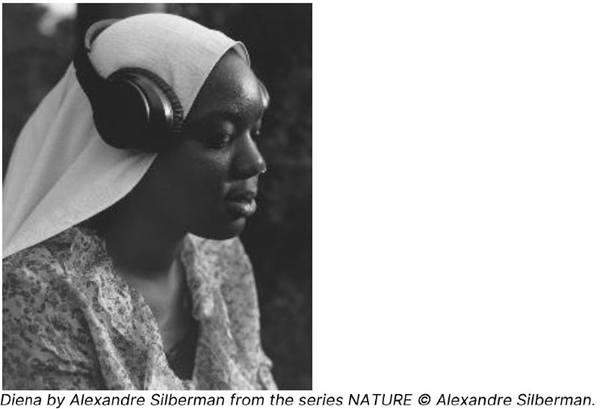
Alexandre Silberman is a director and photographer based in Paris, France, focused on developing long term documentary projects. His work has previously been exhibited in galleries and exhibitions across Europe and the USA, with publications in Marie Claire Korea and Musee Magazine, amongst others.
Silberman's series NATURE explores the intersection of human landscapes and the natural world, and how human interventions such as building a park or urban greenspace creates a hybrid reality between what is natural and what is constructed. Captured in La Courneuve Park, his winning photograph pictures sitter, Diena, in a liminal state where the pattern of the surrounding lawn appears to blend with the pattern of her floral blouse.
The judges felt this portrait encompassed a compelling blend of the traditional and the contemporary. With echoes of art historical depictions of a Madonna, the monochrome palette lends a timeless, oneiric quality to the work. However, details within the image, such as the sitter's nose ring, floral blouse and headphones, feel fresh and current and bring the portrait firmly into the present.
Second Prize £3,000: Gilleam Trapenberg for Kisha and LaDarayon
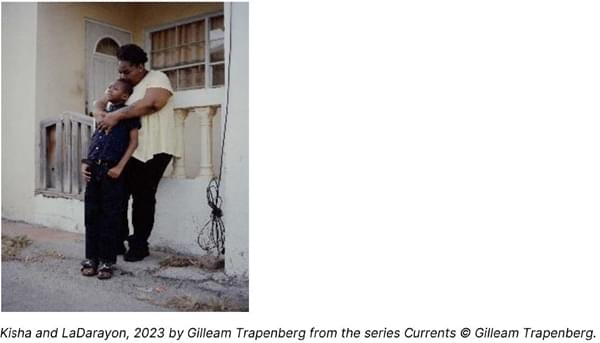
Gilleam Trapenberg is a Dutch photographer, now based in Amsterdam, who was born and raised on the Dutch-Caribbean Island of Curasao. His work explores contradictions and stereotypes of the social landscape of the Caribbean, focusing on vistas beyond tourist tropes to explore a more nuanced and multifaceted understanding of daily life on the islands. His work has been exhibited at the Stedelijk Museum and FOAM Photography Museum in Amsterdam.
Kisha and LaDarayon, 2023 from the series Currents, was captured on the Caribbean island of Saint Martin. Trapenberg has been photographing Kisha and her family since 2018. This particular portrait, captured in 2023, features Kisha outside her grandmother's home with her youngest son, LaDarayon. While Trapenberg's photography typically avoids focusing on particular individuals, his work with Kisha's family is a departure from this norm. His portrait captures a heartfelt moment between mother and son. Trapenberg explains that Kisha, a mother of three boys, embodies the spirit of Caribbean women he grew up with on Curasao.
The judges found this quiet and tender moment between a mother and her son who is on the brink of adolescence very moving. The portrait draws our attention to a profound and relatable moment in the midst of an otherwise ordinary and everyday setting.
Third Prize £2,000: Jake Green for Shaun Ryder
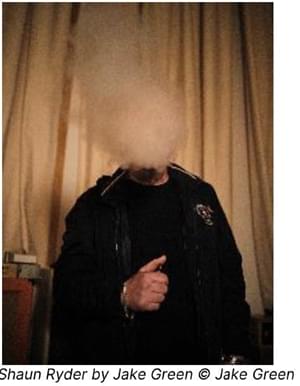
Jake Green is a British, London-based documentary photographer, who creates observational images of people and place. Often working in his home city, Green's most notable work includes Pie and Mash London, documenting the tradition of pie and mash shops, and Drink my Sweat, exploring the production and movement of coffee. His portraiture work has included subjects such as actor Daniel Kaluuya, singer Dua Lipa and author and comedian Big Narstie amongst other notable public figures. Green has also collaborated with global publications and brands such as The New York Times, the Guardian, Converse and Google.
Shaun Ryder, taken in Manchester, was produced for a series documenting influential figures in 1980s music as a commission for Gold Wala and Channel 4. Depicting the iconic lead singer from the Happy Mondays, Ryder's face is obscured entirely by vapour as
suggested by Ryder during the photography session with Green.
The judges were intrigued by being presented with a characterful celebrity portrait where the face is not revealed, but the personality of the sitter is still conveyed.
Third Prize £2,000: Carl Francois van der Linde for Chotu Lal Upside-down
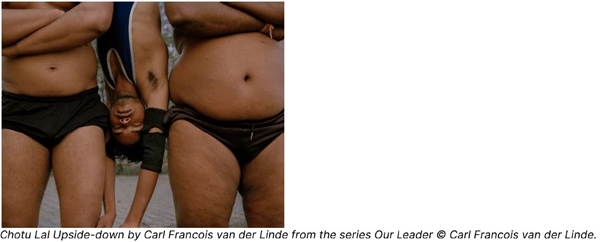
Carl Francois van der Linde is a South African photographer who holds a Bachelors in Commerce Economics and International Trade and Post-Graduate degree in marketing and communication. His work has previously been featured in the PhotoVogue Festival Next Generation Fashion Image Makers 2022 awards and he has collaborated on projects for publications and organisations including DAZED, Elephant Magazine, WePresent and the British Craft Council.
Chotu Lal Upside-down, from the series Our Leader, depicts Chotu Lal a.k.a the Dragon, a professional wrestler from Punjab hanging upside down by his feet from a tree, sandwiched between two much larger wrestlers. The photograph was captured in Jalandhar during Van Der Linde's exploration of the world of Continental Wrestling Entertainment (CWE). The portrait finds Chotu Lal in the midst of building his personal wrestling brand; CWE students often stage humiliation efforts as part of their promotion, recording them and adding the content to social media. This adds to their personal brand and potential virality of their social media pages, hoping to catch the eye of talent scouts.
The judges kept returning to this work to decipher the intriguing composition. The rhythm of the bodies' shapes and forms across the image were unique and captivating.
Taylor Wessing Photographic Commission £8,000: Serena Brown for me nana fie
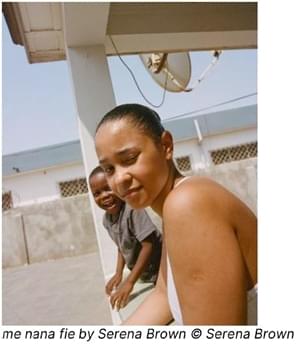
Serena Brown is a British photographer, holding a BA in Photography from Falmouth University. Brown's work often focuses on issues affecting working class youth around the UK, seeking to create honest and authentic portrayals of her subjects. Brown's approach is exemplified throughout her previous projects including Back a Yard, exploring the appropriation of Black and Asian working class youth culture within fashion, and Class of Covid-19, portraying students who's school years were cut short by lockdown in 2020.
Brown's work has appeared in renowned publications. She has captured England Forward player, Chloe Kelly, for Grazia and photographed Editor-in-Chief of British Vogue, Edward Enninful, for The New York Times amongst other photographic projects for brands such as Refinery29, Nike, Google and Pepsi.
Brown's shortlisted photograph, me nana fie, pictures the photographer's younger sister at their grandmother's house in Accra, Ghana. It is part of a larger project capturing the notable characters - friends, family and street sellers - who visit her grandmother. This visit was the first the photographer had made to Ghana since she was two years old. She travelled with her younger sister, Chloe, who had never visited the country before. The portrait captures a sense of homecoming and belonging.
The judges enjoyed the natural and spontaneous feel of this portrait. The sitters are casually posed, but the portrait captures their evocative expressions and emanates a sense of warmth and affection.
The exhibition will also host this year's In Focus Photographer, Hassan Hajjaj. Living and working between London and Marrakesh, Hajjaj's vibrant portraits embrace diverse cultural influences - incorporating references to Western pop art and African studio portraiture, while mixing traditional Moroccan fabrics and motifs with contemporary streetwear and maximalist styling. His work resists stereotypes to fashion and is a unique representation of Hajjaj's own experience of living between British and North African cultures.
Congratulations to the prize winners and all the shortlisted photographers who will be on display as part of the exhibition this year. The Taylor Wessing Photo Portrait Prize always represents the very best of contemporary photographic talent, showcasing the array of unique perspectives and styles at work in the discipline today. It's wonderful to see the Prize and exhibition return to the National Portrait Gallery after three years, and to share these fantastic portraits with our visitors."
Dr. Nicholas Cullinan, Director, National Portrait Gallery
We are proud to support the Taylor Wessing Photo Portrait Prize in its 16th year, which must make it one of the longest-standing partnerships between the arts and the legal profession. This prize is at the centre of our firm's strategy as it promotes creativity, inclusion, and showcases different perspectives - something that is again demonstrated in this year's standout photography from across the globe. Congratulations to the winners, who have all created amazing images, and I am sure will all be delighted to see these works back on display at the newly refurbished National Portrait Gallery.”
Shane Gleghorn, Managing Partner, Taylor Wessing










